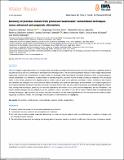| dc.description.abstract | The loss of highly sought-after metals such as gold, silver, and platinum during extraction processes not only constitutes a significant waste of valuable resources but also contributes to alarming environmental pollution. The ever-growing adverse impacts of these highly valued metals significantly increase the contamination of water bodies on discharge, while reducing the reusability potential of their corresponding processed wastewater. It is, therefore, of great interest to identify pragmatic solutions for the recovery of precious materials from processed water. In this review, pollution from targeted precious metals such as gold, silver, platinum, palladium, iridium, ruthenium, and rhodium was reviewed and analyzed. Also, the hazardous effects are elicited, and detection techniques are enumerated. An insightful approach to more recent treatment techniques was also discussed. The study reveals nano- and bio-sorption techniques as adoptable pragmatic alternatives, among other techniques, especially for industrial applications with merits of cost, time, waste management, and eco-friendliness. The results indicate that gold (46.2%), palladium (23.1%), platinum (19.2%), and silver (11.5%) are of utmost interest when considering recent recovery techniques. High yield and cost analysis reduction are reasons for the observed preference of this recovery process when considering groups of precious metals. The challenges and prospects of nanomaterials are highlighted. | en_US |

